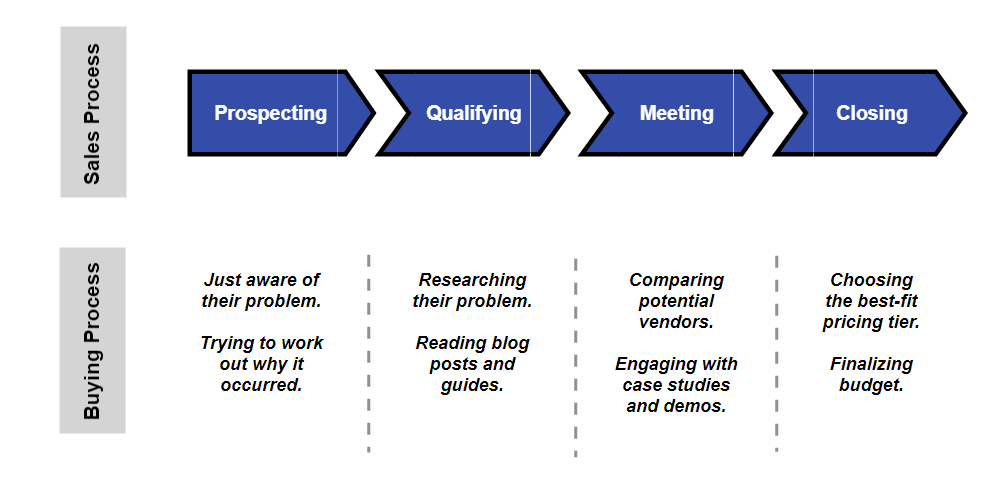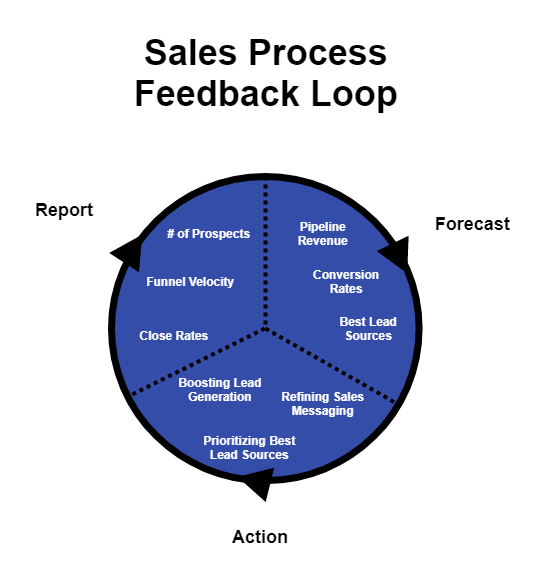How to Create a Customer-Driven Sales Process
Sales is the beating heart of your company. It determines how many leads you can turn from prospects into paying customers. It’s also often the first time a customer interfaces with your business, and it determines the tenor of the relationship moving forward.
Booking new sales can make the difference between survival and extinction for a software company. That’s why it’s often so difficult to master the most important rule of sales: you have to help your customers before you help yourself.
Even if your current process is working, there’s always room to adapt it further around what your customers need. Whether your sales workflow is new and untested or churning out revenue, making small, incremental efforts to be more customer-driven will lead to more efficient prospecting, higher bookings, and increased customer success. Let’s get started.
1. Develop Your Process Around Your Customers
Most people follow a similar process as they evaluate new products:
- Research: Buyers experience a problem and try to identify how other people solve them.
- Evaluation: Buyers evaluate the features and costs for products that can help them solve their problem.
- Purchase: Buyers find a package that fits their specific problem and evaluate how much they’re willing to pay for it.
Although this is a pretty typical process of how buying decisions happen, sales processes are typically constructed around the goals of individual salespeople:
- Prospecting: SDRs research prospective customers and create lists.
- Qualifying: SDRs qualify leads based on the likelihood they’ll turn into paying customers.
- Closing: Account Executives set up meetings, pitch the product, and close.
This often means that your sales process is decoupled from how your potential customer actually makes a decision to buy, and it can lead to lost opportunities because you failed to be at the right place at the right time. While a prospective customer is trying to learn about different options on your blog, you’re needling them for an email or a phone number.
A customer-driven sales process isn’t just valuable for the company in terms of revenue. It’s valuable for the prospective customer, helping them to evaluate their needs and select an option. To unlock that value, you need to revamp your sales process to follow how people actually buy.

At each stage of the sales process, your prospect is trying to solve a different set of problems. The better you understand these problems, the easier it is to shape your sales strategy to solve them.
The more you can understand where your buyers are coming from and what they’re trying to achieve, the more efficient and repeatable your sales become.
In the research stage, you’ll want to share sales-enablement collateral, like blog posts and whitepapers. When they’re comparing different products, you’ll want to show them a case study. Instead of trying to rush them to a sale, you want to prime customers so that they only progress through the funnel when they’re ready to take the next step.
2. Kill Manual Data Entry
Your sales reps are good at their jobs because they love talking to customers and helping them through their deep knowledge of products within the industry. Yet the day-to-day job of a sales rep is filled with mundane, time-consuming tasks such as:
- Scraping the internet for emails and making manual CRM entries
- Keeping track of hundreds of email threads and phone conversations
- Multitasking between endless tools, from Gmail to a CRM to calendar
Although following up relentlessly through email and on the phone is how sales reps close deals, they’re often repetitive tasks that consume tons of your reps’ time. While this may have been necessary 10 years ago, today there are countless tools that help reps automate this type of busy work—freeing up more time for them to actually talk to customers.
- With a single click, data enrichment can populate your CRM with up-to-date contact information for all your prospects.
- Conditional statements—if a prospective customer opens your email and doesn’t respond in two days, then send a follow-up.
- Integrations add contact and lead information directly into your CRM from sign-up forms, Gmail, and other tools.
By drilling down on your workflow and strategically automating your processes, you maximize the time and efficiency of your reps. Your tools should do the heavy lifting—leaving the relationship building to the humans.
3. Build a Feedback Loop to Iterate and Improve
Your sales process isn’t a fixed thing. Your company is constantly talking to new customers, while your team is building useful new features. Meanwhile, new competitors are entering the market all the time.
As sales reps grow more efficient and close more deals, you want to be able to send them more leads. When your paid advertising costs spike and throttle lead generation, you need a way to identify potential shortfalls in revenue. When a sales rep improves their close rate, you want the flexibility to send more prospects their way.
To accomplish this, you need a feedback loop backed into your process, allowing you to adapt that process as you learn new information.

Think of your sales process as a feedback loop, where forecasting and reporting allow you to iterate on what’s working, what’s not—and ultimately improve.
Start by tracking key metrics across your funnel, so you can have a birds-eye view around sales performance at any given time. These will vary from company to company, but some of the most important include:
- Total number of prospects: The number of prospective customers across the sales funnel
- Pipeline velocity: The amount of revenue closed by reps during a given period of time
- Rep performance: Number of opportunities generated, calls, meetings, and deals closed
This helps you measure top-line performance, but you’ll want to dig into metrics that help you use data from today to forecast deals tomorrow. Look at:
- Conversion rates: Identifying how efficiently your reps are closing deals
- Pipeline revenue: Forecasting how much revenue each cohort of customers will generate
- Lead sources: Uncovering what channels your customers are coming from
Last, you want to keep a pulse on the metrics that help you adapt your sales process and identify issues that may become problems down the line. This might include:
- Asking reps to prioritize leads from high-performing channels
- Identifying future dips in pipeline revenue and bolstering lead generation to compensate
- Creating sales-enablement materials and content, from blog posts to whitepapers, to nurture leads
Your sales process is constantly moving—and that’s the way it should be. Keeping a tab on key metrics and identifying opportunities to improve should be the cornerstone of your process.
4. Nurture Relationships Beyond the Close
Most salespeople think that the sales process ends once a prospect is closed and handed off to customer success. But in a world where it’s easier than ever to switch between tools, and you’re generating revenue through recurring subscriptions, sales is no longer just about closing the deal. It’s about building relationships with customers who will stick around in the years to come—and increasing the lifetime value of each customer through upselling and cross-selling between products.
The buyer’s journey doesn’t end once the first deal is closed—it extends through the entire customer experience. To build a customer-driven sales process, you have to adapt your sales process to help them succeed even after the close.

The diagram above from Kissmetrics shows the importance of helping customers succeed across their entire journey. It breaks down the journey into key milestones that reps can help customers reach at each stage to be more successful.
Sales and customer success both operate on a continuum of the customer experience.
Instead of viewing sales and customer success as distinct, unrelated entities, they need to be treated as a continuation of the customer experience. That means that your customer success reps need access to the data in your sales CRM. Meanwhile, your reps should know what types of customers are most successful with the product via product data—and adjust how they qualify prospects accordingly. Generating revenue is a two-way street between success and sales.
The Perfect Process
You’ll never build the perfect revenue-generating machine if all you’re thinking about are deal sizes and dollars. Instead, look to improve your process as a way to better manage customer relationships.
In today’s world, sales no longer is a transactional, singular process—it’s an ongoing partnership between businesses. Rather than constantly trying to optimize around sales targets and quotas, adapt your process around the needs of your customers.
This is a guest post from ProsperWorks. To learn more about building a customer-driven sales process, check out the ProsperWorks blog.
Latest posts by FollowUp (see all)
- CRM Integrations: Sometimes Less Is More - March 18, 2021
- Becoming an Account Executive in 5 Totally-Doable Steps - January 29, 2021
- 3 Bad Sales Techniques You Should Give Up Right Now - December 28, 2020


